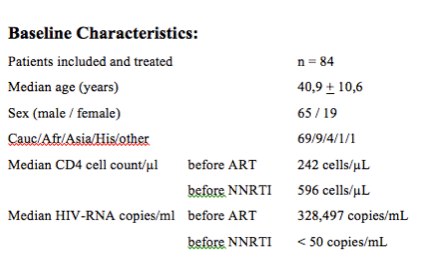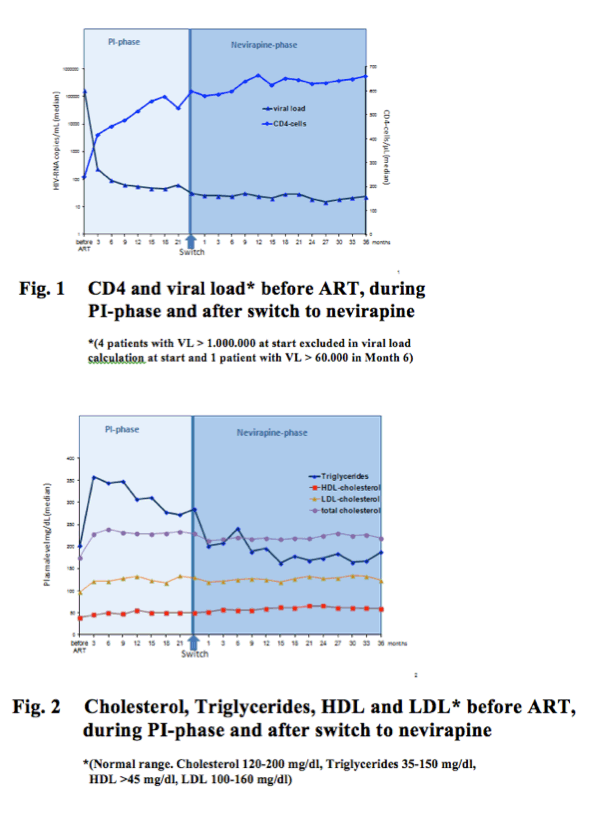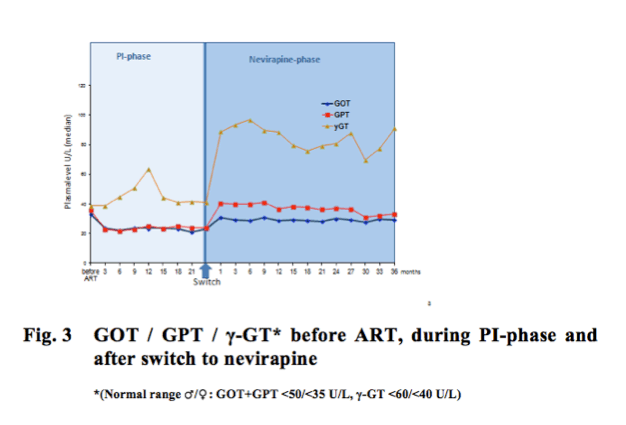 |
 |
 |
| |
LONG TERM DURABILITY OF NEVIRAPINE BASED ART IN A COHORT OF 84 PATIENTS AFTER INDUCTION WITH PROTEASE INHIBITOR TREATMENT
|
| |
| |
Reported by Jules Levin
Glasgow 2012 Nov 11-15
1J. A. Rump, 1J.Hoehl, 1C.Rosenberg
1Practice of Rheumatology and Clinical Immunology, Merianstr. 5, D-79098 Freiburg
Conclusions:
Long-term durability of nevirapine-based ART regimens following an induction phase with PIs is given. No cases of treatment failure due to resistance mutations was seen in a follow-up of more than 48 months. Liver toxicity was not seen in either female or male patients when ART was changed to nevirapine.
The study was funded by Boehringer Ingelheim.
Purpose of the study:
How to start antiretroviral therapy (ART) is still a question open to debate. This retrospective study shows the results of a de-escalation strategy that started with a protease inhibitor (PI), followed by a nevirapine-based regimen over a period of five years.
Methods:
All patients were ART na´ve and received PI in combination with two NRTIs. The PI was changed to nevirapine once the viral load (VL) had stayed below the detection limit (50 or 40 copies/ml plasma respectively) for at least 12 months. The median time to negative VL was measured. CD4, VL and liver tests were followed in 84 patients over at least 5 years including the time before ART, during the PI phase and over a median of 48 months after the change to nevirapine. Resistance tests were performed - if possible - in patients before initiating ART.
Treatment Strategy:
ART na´ve patients -> PI-containing combination therapy
Time to negative viral load (VL) plus 12 months negative VL
->Switch to nevirapine plus a NRTI backbone and 3 years follow up

Summary of results:
19 female and 65 male patients were treated for an average of 28 months with a PI-based therapy (57x Lopinavir, 5x Indinavir, 7x Invirase/r and 2x Fortovase/r, 9x Nelfinavir, 4x Ritonavir-Mono plus two backbone NRTI in various combinations). There where 2 cases of Hepatitis B and 3 HCV positives in the cohort. Mean CD4 count before starting ART was 242/μL + 166 (8/651, min/max) and the average VL was 328,497 copies/mL in plasma (range 1.05x106- 9x106 HIV-RNA copies/mL). The median time to negative VL was 192 + 179 (28/468, min/max) days. CD4 cell count rose by 354/μL during the PI-based treatment to 596/μL + 292 (min/max 148/1676). This was followed by a steady increase of another 65 cells/μL up 662/μL during the follow-up of 36 months after changing to nevirapine (Fig. 1). The median follow-up after de-escalation to nevirapine was more than 48 months. In PI-phase total cholesterol and triglycerides rose from median 175 mg/dL to median 229 mg/dL and from 203 mg/dL to median 285 mg/dL respectively. After switching to nevirapine plasma levels of triglycerides normalised, total cholesterol and LDL stabilised, whereas HDL further increased by about 17% up to month 36 (Fig. 2).
Although the median CD4 cell count was above 400/μL in all patients when changed to nevirapine, no severe liver toxicity was seen in the cohort.
Change to NNRTI was safe even in the group of 19 women with CD4-cells above 400/μL (median CD4 549/μL).
Allergic skin reactions where seen in 7 out of 84 patients during the first 3 months after changing to nevirapine. No events of resistance were seen in the group of 84 patients before or during treatment.


|
| |
|
 |
 |
|
|